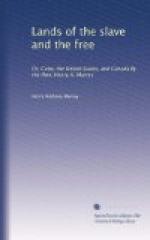He might have easily ascertained that such men as Oersted, Ampere, Arago, Sturgeon, had mastered in detail the various scientific difficulties that stood in the way of the accomplishment of the long-desired object; and he might also have known that Cooke in England and Stienhiel in Germany had both overcome the practical difficulties before Professor Morse had enlightened the Republic with his system, which—like Bain’s—is simply another method of producing the same result—i.e., telegraphic communication.
Mr. Cooke took out his patent in conjunction with Professor Wheatstone, whose attention had long been turned to this subject, and whose name has been so much before the public, that not a few persons attribute the telegraph to him exclusively. There was, indeed, some dispute between them as to their respective claims, and the matter was referred to Sir I. Brunel and Professor Daniell for arbitration. The burden of their decision was, that Mr. Cooke was entitled to stand alone as the gentleman to whom Great Britain is indebted for having practically introduced and carried out the telegraph as a useful undertaking; Professor Wheatstone’s profound and successful researches having already prepared the public to receive it.—So much for the justice of the American claim to the invention, which, like steam, has been the produce of many heads, and was brought into practical use first by Cooke, then by Stienhiel in Germany, and lastly by Morse in America.
Another invention of which the public have heard no little discussion lately is the reaping machine. To the American nation doubtless belongs the credit of forcing it into notice and into use; but as for any claim to the invention, it is equally certain they have none. That honour is due solely to the Rev. Patrick Bell, a Scotch minister in the presbytery of Arbroath. He first tried his reaping machine in August, 1828, at his father’s farm on Lord Airlie’s estate, where it has been in yearly use ever since; and in October he exhibited it at the Highland Society’s meeting at Glasgow. The principle upon which his first machine was made differs in nothing from those making at this hour; and, as some of the people employed on his father’s farm migrated to America, it is only reasonable to suppose they carried sufficient information with them to explain the machine. American ingenuity soon copied, and American energy soon gave an impulse to, Mr. Bell’s machine, for which, though denying them the invention, we ought not to deny them our thanks.




